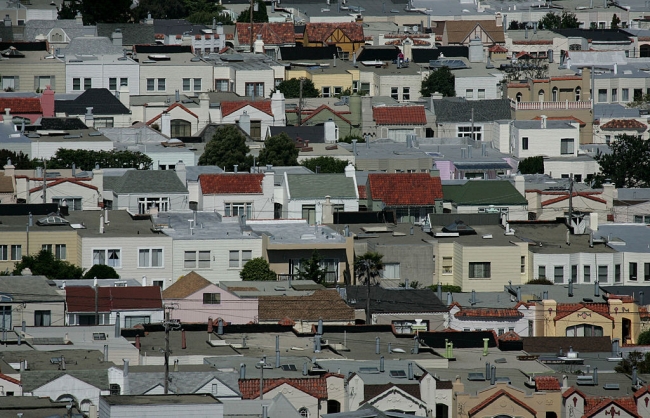You have /5 articles left.
Sign up for a free account or log in.

Justin Sullivan/Getty Images
Homelessness in San José, Calif., the 10th-largest city in America, has increased 42 percent in the last two years. And that figure only looks at the number of people sleeping outside, not those sleeping in hotels or on friends' couches.
It’s not hard to see why things are changing. The tech sector in San José, which is nestled in the heart of Silicon Valley, is unsurprisingly booming. The area is less than a half hour drive from both Apple’s headquarters and the “Googleplex,” the search engine giant’s 20-building campus.
Charlie Faas, the chief financial officer at San José State University, said that while the area is adding jobs at an impressive rate, housing production hasn't been able to keep up. As a result, housing prices have become astronomical.
The yawning gap between haves and have-nots is increasingly visible in many American cities, but nowhere is it quite as stark as in California's Bay Area.
Much attention has been paid to public university and community college students who, faced with no other options, are falling into that gap.
In the 2016-17 academic year, about 11 percent of students at the California State University system (which includes San José State) were homeless. Early last year a student group asked the San José State administration, among other requests, to set aside 10 parking spots for students who sleep in their cars.
But faculty and staff members at California universities also have felt the burden of rising rents. Many live far away and commute for hours each day. Others live with roommates or in small apartments with family.
A 2019 study by Apartment Guide found that the average studio apartment in San José rented for $2,484 per month.
Arthur Cordova, a groundskeeper at San José State, commutes every day from Manteca by commuter train. It takes him about four hours round trip.
“That was the only way I could purchase my own home,” he said. “I did it for my family.”
He’s worked for the university for 19 years.
Cookie Galvan, an office clerk for the university for over two decades, has lived in an apartment with her daughter and her daughter’s family for nearly five years. In the last two years, her monthly rent has increased by $450. Now her family is moving to another state.
“I am 58 years old, and I have to find a roommate,” she said. “Will this person steal from me? Rob me? Not pay the rent?”
Galvan injured her knee in late 2018 and as a result hasn’t been able to work her other two part-time jobs as a security officer and an usher. She’s looked at other housing in the area but doesn’t qualify to rent or wouldn’t be able to front a security deposit along with the first month's rent.
“I can’t afford to leave, and I can’t afford to stay,” she said. “If I don’t find somebody by March, by April I’ll have to give a notice and I’ll be living in my car. Or maybe I’ll be sleeping in my office.
“I’m just petrified.”
Neither Galvan nor Cordova believes their situations are unique.
Preston Rudy, a sociology professor at San José State and president of the faculty union there, said housing is a huge problem for instructors as well.
“We pretty regularly hire people, then they last a little while and then they feel they can’t make it, in part because of the housing crisis,” he said. “And they leave.”
This problem is not unique to the university, he said, but one that unfortunately affects many other people in the region.
“Working people in the Bay Area are having to move further and further away and make longer and longer commutes. It’s a pervasive problem,” Rudy said. “The Bay Area hasn’t done enough to address these problems.”
Though not every day, Rudy himself commutes from Sacramento.
Creative Solutions
The university has acknowledged the housing crisis and to some extent made addressing it a priority.
Faas explains that San José State, despite the higher cost of living in the area, isn’t able to offer faculty members more money than can its peers in the CSU system. Union-negotiated salary scales for both faculty and staff apply to all 23 universities, regardless of geographic location.
“[Faculty recruits] quickly realize they’re not going to live anywhere near the campus,” he said. “They’re going to live an hour, two hours, an hour and a half away from the campus, having to commute in here on that type of salary.”
“What they quickly do is they fall in love with California and they end up going up to [CSU campuses at] Stanislaus or Sonoma or Humboldt or one of these lower cost of living areas,” he said.
So the university is now investing heavily in building subsidized housing for faculty and staff.
“Four years ago we looked at this situation we found ourselves in and said if we don’t look at faculty and staff housing and giving people options, we’re going to, sometime in the near future, be faced with a massive, massive problem,” Faas said. “You have to find ways than are different than we’ve ever tried to do here.”
The university already provides about 50 housing units for faculty and staff, but it is pushing for more placements and more subsidies.
The hallmark of San José State's campaign is the Alquist Building, about one block from the university, which once housed state government offices. Early this year California, after prodding from state lawmakers, transferred the building and land to the university. San José State plans to build 800 to 1,200 apartments on the land for faculty, staff, graduate students and students with families. (The university is also planning on substantial investment elsewhere in student housing and housing grants.)
Through eliminating land costs and any expectation of profit, Faas said the university can easily get units to 80 percent of market value, although they’re looking to go lower.
“This is one of those 'wow' moments, that this could really happen and this could make a difference for our faculty and staff,” he said.
President Mary Papazian said early in her tenure she realized the university needed to have affordable housing options to continue recruiting accomplished and diverse talent.
“When the development of the Alquist Building is completed as planned, it may very well be one of the most important projects ever completed at San José State. It will definitely be a unique model in converting a state-owned building into affordable housing for our campus community,” she said via email. “Long-term, sustainable solutions take some time, of course, but we are happy to be addressing it now and putting real resources behind it.”
Faculty and staff seem hopeful about the potential of the Alquist Building. But they acknowledge it will be more helpful for future staff members.
“It’s positive that the university is thinking about trying to develop solutions to address the difficulty of getting housing for faculty,” Rudy said.
Other universities, especially those in urban areas, have not been immune to the housing crisis.
San Francisco State University only has enough housing for 4,000 of its 30,000 students, and some have become homeless. In 2018, a City University of New York survey found that 55 percent of students who responded to a survey were housing insecure in the past year. It seems likely that faculty and staff at CUNY and San Francisco State may be struggling as well.
Stanford University, just 25 minutes away and also in one of the most expensive housing markets in the country, has for its part developed hundreds of faculty and staff units, some below market rate for those who are eligible.
Stanford, though, has an endowment of over $27 billion. San José State’s endowment is $153 million, 180 times smaller than Stanford’s. San José State also serves twice the students that Stanford does.
Galvan said she hopes San José State prioritizes the neediest at the Alquist Building, with a sliding scale or income ceiling. She’s worried people like her may still be left behind.
The university says it’s too soon to say who will get priority.




